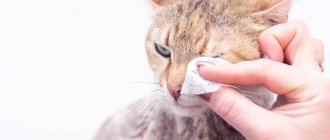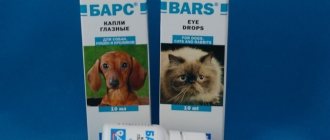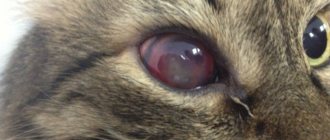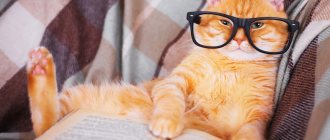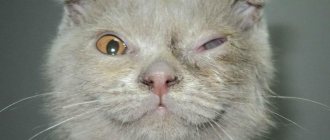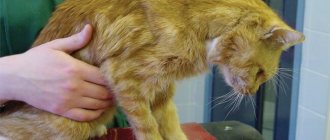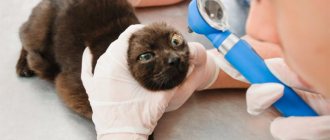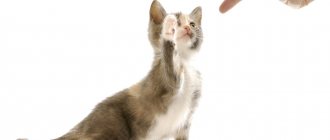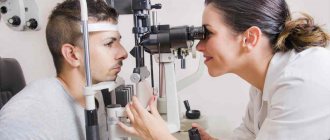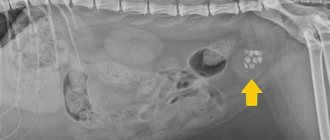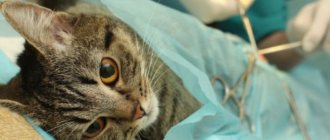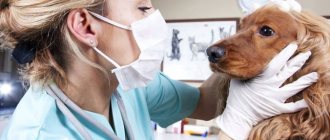Cats are intelligent animals that communicate in several ways. The most common way is with the eyes. When their eyes are closed, they usually feel most comfortable and relaxed.
Cats close their eyes when they trust their owners. Cats are always ready to run away from predators, so closed eyes indicate that your cat feels safe. Cats close their eyes while sleeping, even if they are attentive to what is happening around them. They close them while grooming and when being petted because they love the feeling. However, closed eyes also indicate eye injury, infection, or respiratory infection.
If you're interested in learning about the most common reasons why cats close their eyes, this guide explains everything you need to know.
Classification of diseases
Problems of the visual organs can be divided into two large groups: inflammatory and non-inflammatory. It is also worth noting that eye disease can only be a symptom of some other animal disease .
In this case, treatment of vision alone will not bring results. According to the course of the disease, it can be divided into subacute, acute and chronic. In any case, the symptoms will never disappear on their own; they can only subside, which will soon lead to loss of vision and serious problems.
Inflammatory eye diseases in cats include both those affecting the eyeball itself and problems with the canal, tissues surrounding the eye and orbit. This includes conjunctivitis, keratitis, iritis, and various inflammations of the nasolacrimal duct.
Non-inflammatory - injuries, bruises, foreign bodies, eyelid inversions. This group also includes glaucoma, cataracts, ptosis and other less common problems.
When no treatment is required
Treatment of a prolapsed third eyelid is in some cases unjustified. If a cat has the flu and has a low immune system, medicinal eye drops or ointments are not prescribed. Exceptions also include severe weight loss, dehydration, and the rehabilitation period after surgery or a serious illness. In all of these situations, it is necessary to regulate feeding and drinking regimen. The owner should follow all the veterinarian’s recommendations for caring for a weakened pet. After regaining strength, the condition of the eye analyzer will improve naturally.
Conjunctivitis
This disease is known to everyone - it is one of the most common. Conjunctivitis is an inflammation of the conjunctiva, the mucous membrane of the eyelids. It is often a symptom of other global pet health problems.
Symptoms
In the photo of sick animals you can clearly see which symptoms of conjunctivitis are most active. These include watery eyes, swelling and redness of the eyelids, and noticeable clouding of the eye.
Causes
Many factors can cause inflammation of the conjunctiva. This is why conjunctivitis is so common. The main reasons for its appearance include:
- fungi, bacteria and viruses. They can affect only the membrane of the eyelid, or they can affect the entire body of the animal;
- damage and injury that violate the integrity of the protective membranes, thereby allowing infection to pass through;
- allergens (in this case, conjunctivitis is just one of the symptoms. Itching, runny nose, and sneezing may also occur);
- colds, weakened immunity;
- parasites;
- ultraviolet radiation.
Types of conjunctivitis
Based on the manifestation and source of inflammation, conjunctivitis is divided into four types that can transform into each other.
- Catarrhal . It is easily treated if measures are taken in time. Characterized by swelling, lacrimation and mucous discharge. Possible eversion of the eyelid. If you do not fight the disease, it goes into the next form.
- Purulent . Identified by the discharge of pus. Depending on the severity, it can be just yellow crusts in the morning, or obvious yellow-green pus. The eyelids may stick together. Serious complications and loss of vision are possible if you do not contact a veterinarian promptly.
- Phlegmonous . With this type of conjunctivitis, pus accumulates under the skin, so independent treatment is impossible.
- Follicular . This type is chronic. With it, not only the conjunctiva becomes inflamed, but also the inside of the third eyelid. Treatment is often impossible without surgery.
The first form can be cured on your own. Tetracycline ointment 1%, which can be easily purchased at any pharmacy, will help with this. Use a cotton swab to apply it to the lower eyelid of the animal. Repeat the procedure several times a day.
If treatment does not bring results, or a purulent form of conjunctivitis is possible, you should immediately consult a veterinarian.
Diagnosis and treatment of the third eyelid
To establish an accurate diagnosis and prescribe effective treatment, you need to contact a veterinary clinic and see a specialist - a veterinary ophthalmologist. The doctor examines the condition of the pupils and corneas. To do this, a fluorescein test is taken to detect defects in the cornea and conjunctiva, tonometry to determine eye pressure, and an eye examination using magnifying devices. The veterinarian performs a physical examination using tweezers. In some cases, local anesthesia is given before this.
If your third eyelid has prolapsed, laboratory tests may be needed. For this purpose, general blood biochemistry is prescribed. To rule out serious brain diseases, the doctor prescribes a referral for an X-ray of the skull, ultrasound of the soft tissues around the eye, computed tomography or magnetic resonance imaging.
global $ads_google; //data-ad-slot=”2475549904″ $ads_google = empty($ads_google) ? false : true; ?> if ($ads_google == false) {?>
$ads_google = true; ?> } ?>
If the problem of third eyelid prolapse occurs in both eyes, then most likely the cause is a malfunction of the body or a disease. If the inflammation is local on the right or left, then most likely it is the result of an injury or allergy.
Neoplasms
Tumors of the third eyelid in cats are rare. They can be benign (adenoma, papilloma) and malignant (melanoma, hemangiosarcoma, leiomyoma). Neoplasms are accompanied by thickening of the tissue, darkening or redness of the affected area, changes in the shape and mobility of the eyelid.
If the tumor is small, the growth is removed from the cat without touching the nictitating fold. If the neoplasm has grown to a large size, then it is excised along with the membrane. However, such an operation entails actual loss of vision, as this threatens with drying of the eyeball (keratitis) and chronic conjunctivitis. If a tumor is detected, veterinarians offer combined treatment, including surgery, cryodestruction, and chemotherapy (in case of a malignant nature).
Injury
The conjunctival fold may be damaged by a foreign object or claw. Rupture and prolapse are accompanied by bleeding, blepharospasm, and discharge of pus. If the injury is small, the eyelid will gradually heal on its own without surgery.
Due to serious damage, not only the nictitating membrane suffers, but also the adjacent cartilage. The torn edges of the fold protrude onto the border of the lower eyelid. In this case, the cat must be operated on. The torn parts are stitched together, restoring the integrity of the structure and its normal mobility. After surgery, the cat is prescribed topical antibiotic drops. At first, the pet should be in a cap.
IMPORTANT!
In case of injury, you should immediately contact a specialist. The sooner help is provided, the greater the chance of returning the eye to functionality.
Fungi, viruses, bacteria
In case of inflammation of the third eyelid, it is necessary to establish the nature of the infection, since the type of pharmaceutical agent for treatment depends on this. In case of bacterial infection, antibiotics are prescribed in the form of drops and ointments:
- Erythromycin.
- Gentamicin.
- Ciprofloxacin.
- Tetracycline.
- Levomycetin.
To combat parasitic fungi, fungicidal ointments are used. The course of treatment and frequency of procedures depends on the chosen medication and the degree of damage to the conjunctiva. Complex therapy includes vitamin and mineral supplements, immunomodulators. The cat must be provided with good nutrition.
global $ads_google; //data-ad-slot=”2475549904″ $ads_google = empty($ads_google) ? false : true; ?> if ($ads_google == false) {?>
$ads_google = true; ?> } ?>
Foreign body
During a walk or renovation of the house, dust or larger particles may get into the cat's eyes. They cause redness, itching, and if not treated promptly, they can become a source of infection and cause not only inflammation, but also ptosis of the inner eyelid. In such a situation, the cat needs to rinse its eyes. It is best to use a disinfectant decoction of herbs (chamomile, string), a solution of furatsilin, boric acid or chlorhexidine for this.
The cat's eyes are washed with a cotton swab dipped generously in liquid. If the foreign object is not washed out with tear secretion and rinsing solution, then it is removed from the eye with a twisted cotton swab. In difficult situations, you must seek help from a veterinarian.
Allergic conjunctivitis
If a cat’s bilateral third eyelid entropion occurs due to contact with an allergen, then the first aid is to wash the eyes. For this you can use regular saline solution. Next, an antihistamine ointment based on corticosteroids (prednisolone, dexamethasone) is placed under the eyelid or a liquid product with a similar composition is instilled.
The cat is prescribed treatment with antihistamines (Tavegil, Suprastin). If allergic conjunctivitis is not accompanied by an infectious process, then it is not advisable to treat the animal with antimicrobial drugs.
Parasites
If the third eyelid is inflamed due to helminthic infestation, then the pet will experience other accompanying symptoms. This fact is established from them, as well as from the results of laboratory tests. Antihelminthics (Pratel, Milbemax) are prescribed for treatment. In case of severe parasite damage, the cat requires infusion therapy. A weakened animal is injected with Ringer's solution and saline solution. To more quickly remove worms and decomposition products from their bodies, laxatives are given, for example, Glauber's salt.
global $ads_google; //data-ad-slot=”2475549904″ $ads_google = empty($ads_google) ? false : true; ?> if ($ads_google == false) {?>
$ads_google = true; ?> } ?>
Keratitis
Keratitis is a lesion of the cornea of the eye. It can be caused by either trauma, including foreign body impact, or infection. The main symptoms of keratitis are:
- photophobia;
- profuse lacrimation;
- corneal clouding;
- accumulation of discharge in the corner of the eye.
When treating keratitis, it is important to exclude the possibility of its relapse : eliminate the cause of the disease. Effective drug intervention is impossible without the help of a veterinarian. Only a specialist can correctly determine the cause of the disease and prescribe the correct therapy.
Why do cats close their eyes when they sleep?
Cats sleep for approximately 12-16 hours and fall asleep very quickly. Since they are most active at night, they sleep all day to conserve their energy, which prepares them for nighttime wandering and hunting.
The first reason why cats close their eyes while sleeping is that it gives them the darkness they need to sleep when there is light during the day. Some cats hide under beds in the dark, but felines that enjoy being close to their owners cover their eyes with their legs.
© shutterstock
Cats also go through two main stages of sleep. The first is rapid eye movement (REM). According to the US National Library of Medicine, rapid eye movements are accompanied by loss of muscle tone, muscle twitching and wakefulness-like cortical activity.
During this stage of sleep, the cat's brain reflects its activity while it is awake. This is also the time when cats dream most often. As a result, cats close their eyes at this stage because their muscles are too relaxed to keep them open.
Another stage of sleep is non-rapid eye movement (NREM) sleep. This is the deepest stage of sleep for a cat, allowing it to recover its body after a night of wandering and hunting.
Cats in NREM are vulnerable. In the wild, this is the time when predators are most likely to attack. At home, cats hide in a safe shelter. Finding shelter allows them to stay safe and sleep without fear.
Third eyelid
Normally, the nictitating membrane (nictitating eyelid) performs an important protective function.
However, with some pathologies, the nictitating membrane may fall out and the so-called “third eyelid” may form in the cat. It begins to form in the corner of the eye and looks like a white film. In the normal state, it is visible only when the animal blinks or tilts its head. If you see this white film in other cases, a visit to the veterinarian is necessary.
Third eyelid prolapse is rarely an independent disease. Most often, this is a sign of other, more serious, pathological processes in the pet’s body.
Symptoms of eyelid loss are:
- redness of the conjunctiva;
- swelling;
- secretion of mucus, pus;
- lacrimation;
- formations in the corner of the eyes (the third eyelid itself);
- itching and fever are possible.
During treatment, medications are prescribed that relieve symptoms and also eliminate the cause of the disease.
Causes of third eyelid prolapse
global $ads_google;
//data-ad-slot=”2475549904″ $ads_google = empty($ads_google) ? false : true; ?> if ($ads_google == false) {?> $ads_google = true; ?> } ?> With a quick glance at the cat, it is difficult to immediately determine the cause of the swelling of the thin fold. It can be associated with both external influences and internal factors. Veterinarians name a lot of reasons for the loss of the third eyelid:
- Infection of a bacterial, fungal or viral nature;
- Impaired functioning of the liver, intestines, kidneys;
- Hormonal imbalance in the body;
- Severe exhaustion, dehydration of the body;
- Weakening of the ligaments and muscles of the eye;
- Inflammatory process in the auditory analyzer;
- Introduction of foreign bodies into the mucous membrane of the eye;
- Infection with parasitic worms;
- Mechanical damage to the eye area;
- Development of allergic conjunctivitis;
- Benign or malignant formation;
- Malnutrition of the eyeball (atrophy);
- Deformation of the elastic cartilage of the third eyelid;
- Eye size that is too small (microphthalmos).
Problems with the conjunctival fold can occur in cats of any breed, age, or gender. However, it has been noted that the Persians and the British are the most sensitive in this regard. Genetic predisposition increases the risk of third eyelid prolapse in cats of these breeds, regardless of the cause.
ON A NOTE
:
In rare cases, the nictitating membrane becomes noticeable in an animal after castration and under severe nervous stress.
Blepharitis
Inflammation of the eyelids, which is quite common in furry cats, is divided into three types:
- Scaly blepharitis (also called simple);
- Ulcerative blepharitis;
- Meibomian blepharitis.
Symptoms differ for each type, but there are common ones that are always noticeable. Namely:
- Itching;
- Edema;
- Redness;
- Tearing.
With scaly blepharitis, you can notice a clear thickening of the eyelids, after which gray scales appear there. Over time, the eyelashes will begin to fall out, and pus will be released in place of the scales.
If treatment is not started, scaly blepharitis can quickly turn into ulcerative blepharitis. With it, crusts of pus dry out, fall off, and in their place sores open. The inflammation gets worse. Scarring may cause the skin to tighten.
Meibomian blepharitis is similar to a stye. The eyelid swells and turns red. Pus begins to ooze out profusely.
Why do cats close their eyes when you pet them?
Most cats love to be petted by their owners. It brings them pleasure and calms them down. Touch is also a means of communication between cats and their owners. Cats don't naturally trust animals. People have to earn it. As a result, when cats close their eyes when being petted, it is because they trust you.
Cats prefer to remain vigilant, keep their eyes open and their instincts sharp. This is done so that they can avoid danger. When they close their eyes, they know you pose no risk and mean no harm.
According to Live Science, cats like to feel around the base of their ears, under their chin, and around their cheeks. This is where their sensitive facial glands are located. When cats enjoy petting, they close their eyes and show the following signs:
- Vertical tail
- Purr
- Kneading with front paws
- Relaxed pose
- Ears facing forward
- Push your head
However, keep in mind that cats do not always enjoy being stroked on their bellies, backs, and the base of their tails. Signs of petting stress include:
- Whistling Tail
- Ears flattened to the sides
- Ears rotate backwards
- Skin twitching
- Sudden turn of head
- Exaggerated flashing
- Nose licking
- Clapping or waving a paw
- Wide eyes and pupils
If you notice any of the above signs, try petting a different area on your cat's body and avoid those sensitive areas.
© shutterstock
Methods for treating eye diseases in cats
If your cat squints or squints, it needs to be seen by a veterinarian. The specialist will find out the cause of this phenomenon and prescribe treatment.
However, not everyone has the opportunity to immediately take their pet to the clinic. In this case, it is recommended to examine the animal at home and provide first aid.
To do this you need:
- check whether a foreign body has entered the eye;
- rinse the damaged visual organ with saline solution or warm boiled water;
- Carefully remove the pus, moving from the outer corner of the eye to the inner.
Without the doctor's permission, it is prohibited to use antiseptic solutions or antibiotics for rinsing and treatment. Medicines, eye drops and ointments are prescribed only by a veterinarian after diagnosis.
Severe cases require surgery and suturing. This treatment is carried out in a hospital setting.
When to see a doctor
Situations in which it is necessary to immediately take your pet to a veterinarian:
- Bleeding from the eye. Foreign objects are stuck in the cornea.
- There is pus coming out of the eye.
- Complete prolapse of the lacrimal gland, in which the fleshy part protrudes from the eye.
- The eye inflammation does not go away within several days.
- Inflammation of the third eyelid is accompanied by other symptoms of the disease: increased body temperature, decreased activity, refusal to eat, and others.
First, the doctor will conduct a diagnosis. For treatment to be effective, it is necessary to determine the exact cause of third eyelid prolapse. In most cases, veterinarians try to solve the problem with medication.
If the eye has been injured, all foreign objects must be carefully removed. Rinse the eye itself and remove accumulated pus. To prevent the cat from scratching its eyes, it is necessary to put a special collar on the animal until the wound is completely healed.
We recommend the article: Lump on a cat’s back: what is it and what to do about it?
If the eye becomes infected, your veterinarian may prescribe antifungal, antimicrobial, and antiviral medications. In addition, to maintain the body, the animal is given immunomodulatory agents.
If an allergy is detected, antihistamines and hormonal drugs will help cope with it. In addition, it is important that the animal can no longer come into contact with the allergen. Therefore, if a cat has an allergic reaction to plants, then it is better to remove the flowers to another room.
If the problem is with household chemicals, then they need to be replaced or more gentle products should be used. Sometimes it is not possible to determine the exact allergen, in which case the cat is injected with hormonal drugs every few months.
In case of pathologies and neoplasms, it is often necessary to resort to surgical intervention. Even in this case, the doctor tries to preserve the nictitating membrane. If it is removed, the cat's cornea will constantly dry out. The animal will require lifelong care. If you do not monitor your cat's eyes after removing the third eyelid, the animal may go blind.
Glaucoma
This is an increase in intraocular pressure due to a decrease in the outflow of intraocular fluid. This pathology leads to a narrowing of the visual fields, and ultimately to complete loss of vision. Glaucoma can be primary or secondary (against the background of the underlying disease). In cats, glaucoma most often occurs after the age of 6 years and is secondary.
Symptoms:
- Redness of the eye
- Watery eyes, squinting (blepharospasm)
- Pupil dilation and signs of concomitant disease (uveitis, tumors) may be observed.
— In the case of an acute attack of glaucoma, the eye becomes cloudy, tortuous vessels on the surface of the eye are clearly visible and severe pain, the eye may increase in size.
Treatment:
1. Drugs to lower intraocular pressure.
============================================================================================================================================================================================
What to do if the cat closed one eye?
First aid
With such symptoms, there is no way to do without a veterinary examination.
Therapy for the condition in which kittens or older cats squint their visual organ is based on stopping the factor that caused the problem. If the owner notices this unpleasant symptom in a pet, the first thing he needs to do is take the animal to a veterinary clinic. The doctor will conduct the required examinations that will reveal the root cause.
If there is no opportunity to quickly deliver the cat to the clinic, the owner will need to independently examine the visual organ that the pet is squinting. It is important to make sure that there are no foreign objects in it. Then you should carefully rinse the cat's eyes with boiled water at room temperature or saline solution. You need to moisten gauze in the liquid and carefully wipe the cat’s eyelids.
It is forbidden to use cotton swabs, since the cotton wool can stick to the fur and then get on the cornea, worsening the pet’s condition. In addition, you will need to stop using antiseptic solutions. These medications can cause a corneal burn. If the problem is accompanied by purulent discharge, it is important to clean the eyes as carefully as possible. A person will need to move from the outer corner to the inner one.
Drug therapy
Certain ailments can be eliminated with the help of drops.
After providing first aid to your pet, a visit to the veterinarian should still take place. After carrying out diagnostic measures, the veterinarian will be able to select the correct treatment regimen. For example, if a cat squints its eye due to the development of conjunctivitis, he is prescribed antibacterial medications. They can be prescribed either in the form of eye drops or in the form of ointments.
When the problem is accompanied by pain, the cat is given painkillers. They often resort to the help of Novocaine, which will need to be instilled twice a day under the lower eyelid of the affected visual organ. If squinting of the eyes is caused by allergic reactions, therapy consists of identifying the allergen and avoiding contact with it. Sometimes pets are prescribed corticosteroids. However, these medications have a number of serious side effects, so they are used in advanced situations.
Prevention measures
The most effective way of therapy is to prevent the problem.
To prevent inflammation of the third eyelid in a cat, use the following recommendations:
- Create a balanced cat diet from quality products.
- Be sure to add vitamins to your food.
- Periodically carry out eye rinsing procedures.
- Monitor your pet for changes in behavior and examine its eyes regularly.
- Visit a veterinarian at least once a year.
Remember, the sooner you detect eye disease in a cat, the greater the likelihood of its speedy cure. You should not self-medicate; you should immediately take the animal to the veterinarian.
Why do cats close their eyes when you talk to them?
Many cats blink slowly when their owners talk to them. Both squinting and slow blinking are forms of communication.
Cats cannot understand the sounds of their owner, but they know that the owner is talking to them, especially when they maintain eye contact.
A Scientific Reports study found that eyes play an important role in communicating emotions in human-cat interactions. Eye narrowing is associated with positive emotional responses.
When people blink slowly along with high-pitched sounds, cats respond by repeating the action. Eye narrowing produces a similar reaction to a genuine human smile.
As a result, it helps establish a strong bond with cats, who recognize this communication technique and repeat it. Although cats do not strictly close their eyes during such communication, it looks very similar and can be mistaken for fatigue.
